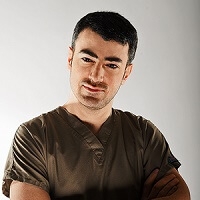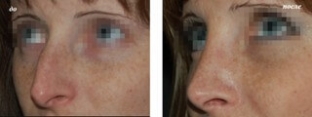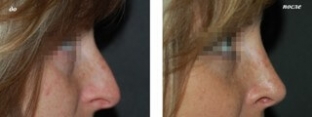Rhinoplasty requires such filigree accuracy of movements from the doctor that it is often compared to jewelry. It is believed that a surgeon who has mastered this technique easily masters any other types of aesthetic operations. About what it means to be a "jeweler" in medicine, we talked with Vladislav Grigoryants, one of the best rhinoplasty specialists in Russia.

Grigoryants Vladislav Semenovich
Plastic Surgeon
Center for Rhinosurgery, Aesthetic and Functional Rhinoplasty
Vladislav Semenovich, is it true that rhinoplasty is the most difficult area in modern aesthetic surgery?
Yes, of course, because in order to change the shape or size of the nose, you have to smooth, move, remove cartilage and bones, change their shape. These manipulations are complex in themselves, and they still need to be carried out in such a way that the intervention of the surgeon remains invisible...
What types of rhinoplasty are there and in what cases are they performed.
I practice closed and open rhinoplasty, as well as mandatory nasal septum correction - septoplasty. In primary operations, the closed method is almost always used, that is, all incisions are made inside the nostrils. Open rhinoplasty, which requires a small incision on the columella, I perform mainly for revision operations, when a more serious, reconstructive intervention is needed. In any case, no scars remain: both closed and open rhinoplasty are primarily aesthetic correction procedures.
Are there medical indications for rhinoplasty?
A relative indication is a collapse of the internal or external nasal valve, i.e. such a deformity of the nose that prevents normal breathing. I will add that when performing rhinoplasty, I almost always correct the nasal septum for patients, regardless of whether they have breathing problems or not. If I don't do this, the deviated septum may "take" the nose and the rhinoplasty will not give the result that was expected.
From an aesthetic point of view, when should you decide on rhinoplasty?
I would say - in case of a clear disproportion: if the nose is too large or too small, with its curvature or post-traumatic deformation, when there is a hump, too wide back or too lowered tip. In addition, rhinoplasty will help correct congenital pathologies - "cleft lip", for example.


How do you work with a patient: he turned to you - what's next?
First of all, this is a consultation. The patient receives all the information he is interested in about the operation and the rehabilitation period, and also, thanks to computer simulation, sees the result that can be obtained. The patient must understand what effect can be expected in his case. Then organizational issues are resolved, I tell in detail how to prepare for the operation. Then tests are taken to identify contraindications for health. Only after that the operation itself is carried out.
Have you ever refused a patient an operation?
When there are contraindications, you have to refuse. Rhinoplasty cannot be performed in case of chronic or systemic diseases, in violation of blood clotting, diabetes mellitus. It happens that the desire to change the appearance is associated with a too picky attitude of the patient to his face, with high expectations from the operation - in such cases, I also prefer to refuse.
What is the hardest thing about rhinoplasty?
The hardest part is correcting the failures of other surgeons. Such cases are not uncommon, and then my responsibility as a doctor is doubled. I must return to a person not only the possibility of a normal life, but also confidence in medicine in general.
What determines the success of the operation?
Perhaps there are several components here, each of which is extremely important. The first is doctor's hands. Turning to a professional surgeon, the patient can be sure that he will not become a practical tool, that he will not be experimented on. The fact is that all rhinoplasty specialists have a set of tools and technologies that is approximately the same, but not everyone knows these techniques well enough. In addition, not every surgeon understands when and what to do. Here you need a flair, but not everyone has it! The second part of success is the strict observance of the doctor's recommendations after the operation. Well, the third ingredient is patience. When agreeing to rhinoplasty, you need to remember that you can fully evaluate the result only after a year.
How difficult will the rehabilitation after rhinoplasty be? How long do the swelling and bruising last?
Nose reshaping is a major operation, but recovery from it is relatively easy. The patient does not experience pain, although some discomfort, alas, is inevitable. Firstly, after the operation, you need to spend a day in a hospital under the supervision of a doctor. Secondly, the nose will be covered with a plaster cast for 10 days. In addition, the first 3 days you can only breathe through your mouth: the nostrils will be closed with tampons to prevent bleeding. Thirdly, swelling and bruising are inevitable after rhinoplasty. By the way, in order not to aggravate puffiness, you will have to give up alcohol. As a consolation to patients, I can say that obvious swelling, like bruises, usually disappears quite quickly. On average, two weeks is enough for the patient to return to a normal lifestyle and go out into the world.
Does it happen that there are no bruises after rhinoplasty?
This is possible if the operation is performed exclusively on the tip of the nose. But this is a rare case, because for such a procedure, the back of the nose is ideal in height and width, and it does not occur often. In other cases, the back of the nose is affected - an osteotomy is made, after which bruising is inevitable.
What is revision rhinoplasty?
This is an additional minor correction that is sometimes needed after the first intervention. It is due to the nature of the operation. If such a need arises, I do re-rhinoplasty for my patients for free.
It must be hard to be the best rhinoplasty surgeon?
It's both simple and complex at the same time. In any case, it requires constant work on yourself. I need to not only perform operations, but also follow the latest trends in rhinosurgery, attend leading scientific conferences. By the way, one of them was held recently in St. Petersburg under the name "Advanced aesthetic rhinoplasty, otoplasty and facial contouring." Its distinctive feature was a huge number of demonstrated operations - such an exchange of experience with leading plastic surgeons is priceless for me. It allows me to offer my patients the best possible solutions and guarantee them a result that meets their expectations.Source estet-portal.com






Add a comment